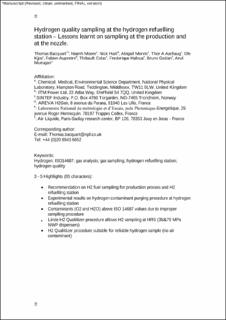Hydrogen quality sampling at the hydrogen refuelling station - lessons learnt on sampling at the production and at the nozzle
| dc.contributor.author | Bacquart, Thomas | |
| dc.contributor.author | Moore, Niamh | |
| dc.contributor.author | Hart, Nick | |
| dc.contributor.author | Morris, Abigail | |
| dc.contributor.author | Aarhaug, Thor Anders | |
| dc.contributor.author | Kjos, Ole Sigmund | |
| dc.contributor.author | Aupretre, Fabien | |
| dc.contributor.author | Colas, Thibault | |
| dc.contributor.author | Haloua, Frédérique | |
| dc.contributor.author | Gozlan, Bruno | |
| dc.contributor.author | Murugan, Arul | |
| dc.date.accessioned | 2020-11-27T11:32:19Z | |
| dc.date.available | 2020-11-27T11:32:19Z | |
| dc.date.created | 2020-02-13T12:21:55Z | |
| dc.date.issued | 2019 | |
| dc.identifier.citation | International journal of hydrogen energy. 2019, 45 (8), 5565-5576. | en_US |
| dc.identifier.issn | 0360-3199 | |
| dc.identifier.uri | https://hdl.handle.net/11250/2689927 | |
| dc.description.abstract | Fuel cell electric vehicles and hydrogen refuelling infrastructure are developing quickly in Europe, the USA and Asia. Hydrogen quality for transport applications requires compliance with ISO 14687-2: 2012 and EN 17124:2018 - this needs representative sampling, at the hydrogen production process and at hydrogen dispenser nozzle (which typically fill vehicles to a Nominal Working Pressure of either 35 or 70 MPa). The low thresholds in ISO 14687-2 for oxygen and water can be exceeded if the sampling procedure fails to purge the system sufficiently, which would lead to false results (60% in this study). Purging requirements to remove water were studied using a low pressure sampling rig. For hydrogen dispenser sampling using the Linde H2 Qualitizer (suitable for dispensing pressures up to 70 MPa), purging number and the effect of the initial fill level of a vehicle compressed hydrogen storage system were investigated experimentally to avoid hydrogen quality violation due to oxygen false positive. The study procedure reduces from 60% to 0% hydrogen quality violation. The next challenges highlighted are safe purging and reliable sampling of reactive contaminants in gas cylinders. | en_US |
| dc.language.iso | eng | en_US |
| dc.publisher | Elsevier | en_US |
| dc.rights | Attribution-NonCommercial-NoDerivatives 4.0 Internasjonal | * |
| dc.rights.uri | http://creativecommons.org/licenses/by-nc-nd/4.0/deed.no | * |
| dc.subject | Hydrogen quality | en_US |
| dc.subject | Hydrogen refuelling station | en_US |
| dc.subject | Gas sampling | en_US |
| dc.subject | Gas analysis | en_US |
| dc.subject | ISO14687 | en_US |
| dc.subject | Hydrogen | en_US |
| dc.title | Hydrogen quality sampling at the hydrogen refuelling station - lessons learnt on sampling at the production and at the nozzle | en_US |
| dc.type | Peer reviewed | en_US |
| dc.type | Journal article | en_US |
| dc.description.version | acceptedVersion | en_US |
| dc.rights.holder | Copyright© 2019 Published by Elsevier Ltd on behalf of Hydrogen Energy Publications LLC. All rights reserved. | en_US |
| dc.source.pagenumber | 5565-5576 | en_US |
| dc.source.volume | 45 | en_US |
| dc.source.journal | International journal of hydrogen energy | en_US |
| dc.source.issue | 8 | en_US |
| dc.identifier.doi | 10.1016/j.ijhydene.2019.10.178 | |
| dc.identifier.cristin | 1793812 | |
| dc.relation.project | EC/H2020/779475 | en_US |
| cristin.ispublished | true | |
| cristin.fulltext | original | |
| cristin.fulltext | postprint | |
| cristin.qualitycode | 1 |
Tilhørende fil(er)
Denne innførselen finnes i følgende samling(er)
-
Publikasjoner fra CRIStin - SINTEF AS [5801]
-
SINTEF Industri [1565]

